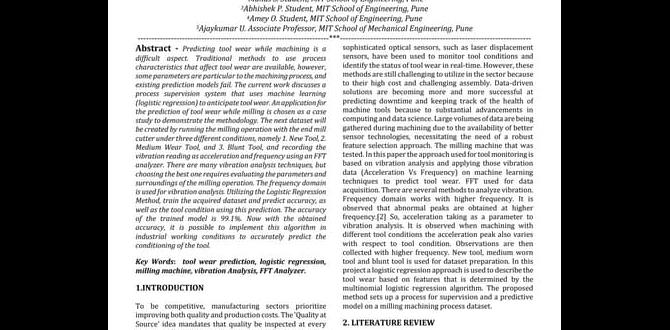3/16″ Carbide End Mills for Inconel: Boost Your Machining Speed (MRR)!
Unlock high material removal rates (MRR) when machining tough Inconel with the right 3/16″ carbide end mill. Learn how specific features like a reduced neck and optimized flute geometry are game-changers for this challenging superalloy. Get ready to cut faster and more efficiently!
Hey there, fellow makers and machinists! Daniel Bates here from Lathe Hub. If you’ve ever wrestled with Inconel, you know it’s a super tough metal that can really test your patience and your tools. Machining it can feel like trying to cut soft butter with a butter knife – slow and frustrating! But what if I told you there’s a way to make Inconel machining much faster and smoother? It all comes down to using the right tool, specifically a 3/16″ carbide end mill designed for the job. Today, we’re diving deep into how you can achieve impressive material removal rates (MRR), even with this notoriously difficult material. We’ll look at the specific features that make a difference and how to use them safely and effectively. Get ready to speed up your Inconel projects!
Why is Machining Inconel So Difficult?
Inconel is an amazing alloy, prized for its incredible strength, heat resistance, and corrosion resistance. These same qualities, however, make it one of the most challenging metals to machine. Think of it this way: its toughness and ability to resist extreme temperatures mean it’s also very resistant to being cut. When you try to machine Inconel with standard tooling, you run into several common problems:
- Work Hardening: As you cut, Inconel rapidly hardens the surface of the material you’re working on. This makes subsequent cuts even harder and can quickly dull or break your tools.
- Heat Buildup: The friction generated during machining creates a lot of heat. Inconel actually gets stronger and harder at higher temperatures, exacerbating the work hardening issue. This can lead to tool failure and poor surface finish.
- Galling and Chip Welding: The sticky nature of Inconel can cause chips to weld themselves to the cutting edges of your end mill, a problem known as galling. This dramatically reduces cutting efficiency and can damage both the tool and the workpiece.
- Machining Forces: Because it’s so tough, machining Inconel requires significantly higher cutting forces, which puts a lot of stress on your machine, fixture, and tooling.
These challenges mean that trying to achieve a high Material Removal Rate (MRR) – the volume of material you can remove per unit of time – with Inconel is tough unless you have the right equipment and techniques. That’s where specific tooling, like a carefully chosen 3/16″ carbide end mill, becomes essential.
The Power of a 3/16″ Carbide End Mill for Inconel
When you hear “carbide end mill,” you probably think of strong, durable tools. For Inconel, however, not just any carbide end mill will do. We need one with specific design features to tackle its unique machining challenges and achieve that elusive high MRR. A 3/16″ end mill is a common size for detailed work or when dealing with smaller Inconel components, and when engineered for superalloys, it can be a powerhouse.
Let’s break down the key features that make a 3/16″ carbide end mill suitable for high MRR Inconel machining:
1. Carbide Material: The Foundation of Toughness
Carbide, specifically tungsten carbide, is the go-to material for machining difficult alloys like Inconel. It’s incredibly hard and can withstand the high temperatures generated. Unlike High-Speed Steel (HSS), carbide retains its hardness at much higher temperatures, which is crucial when cutting Inconel that generates significant heat. This allows for faster cutting speeds and feeds without the tool softening and degrading quickly.
2. Specialized Coatings Play a Big Role
The coating on a carbide end mill is like its protective suit. For Inconel, specific coatings are vital:
- TiAlN (Titanium Aluminum Nitride): This is a very common and effective coating for high-temperature superalloys. TiAlN provides excellent thermal stability, meaning it can handle the heat generated by cutting Inconel. It also forms a protective oxide layer that helps prevent galling and wear.
- AlTiN (Aluminum Titanium Nitride): Similar to TiAlN, AlTiN offers even higher hot hardness and oxidation resistance, making it an excellent choice for the extreme conditions of Inconel machining.
- CrN (Chromium Nitride): While it doesn’t offer the same level of hot hardness as TiAlN or AlTiN, CrN provides superior lubricity and wear resistance. It’s good at preventing chip welding, which is a major issue with Inconel. Sometimes, a combination of coatings is used to leverage the benefits of each.
These coatings reduce friction, dissipate heat, and create a barrier between the tool and the workpiece, all of which contribute to longer tool life and the ability to cut faster.
3. End Mill Geometry for Superalloys
The shape and angles of the end mill’s cutting edges and flutes are critical. For Inconel, we look for:
- High-Performance Helix Angle: A higher helix angle (often 45 degrees or more) helps to efficiently evacuate chips and reduce the cutting forces exerted on the workpiece. This leads to a smoother cut and less stress on the tool.
- Optimized Number of Flutes: For roughing Inconel, you might see end mills with fewer flutes (like 2 or 3) to allow for better chip clearance. For finishing or more precise cuts, 4 flutes are common. For high MRR under optimized conditions, a 4-flute design generally allows for faster feed rates while still managing chips if speeds and coolant are appropriate.
- Strong Corner Radii: A small corner radius can add strength to the cutting edge, preventing chipping when engaging with tough material.
- Specialized Neck Relief: This is where our “reduced neck” comes in!
Let’s talk more about that neck relief, as it’s a key feature for achieving high MRR in Inconel.
4. The Importance of Reduced Neck (or Neck Relief)
A “reduced neck” end mill, sometimes called a stub end mill with neck relief, has a portion of the shank ground away behind the cutting flutes. This might sound odd at first, but it’s incredibly important for Inconel machining. Here’s why a reduced neck is a secret weapon for high MRR:
- Prevents Re-Cutting Chips: When you’re taking deep cuts or milling slots, the chips need to escape freely. Without sufficient clearance, the end mill can re-cut existing chips. This creates immense friction, heat, and puts a huge load on the tool, leading to rapid wear or breakage. The reduced neck provides extra space behind the cutting edges, allowing chips to flow away without obstruction. This is absolutely vital for high MRR.
- Allows for Deeper Engagements: With the extra clearance, the end mill can be plunged or engaged more deeply into the material in certain situations without the shank dragging on the workpiece or the accumulated chips.
- Reduces Rubbing: In narrow slots or pockets, the shank of a standard end mill can rub against the sides of the workpiece, creating heat and wear. The reduced neck design minimizes this contact, leading to cleaner cuts and longer tool life.
For a 3/16″ end mill, this feature might seem subtle, but it makes a significant difference in its ability to perform under the stresses of Inconel. It ensures that the cutting edges are doing the work, not the unswept chips or the tool shank.
Choosing the Right 3/16″ Carbide End Mill for Inconel
Given the challenges of Inconel, selecting the right tool is paramount. For a 3/16″ carbide end mill aimed at high MRR, here are the key specifications to look for, often found in specialized “high-performance” or “superalloy” end mills:
- Diameter: 3/16″ (0.1875 inches)
- Shank Diameter: Often the same as the cutting diameter (3/16″), but you’ll specifically want one with neck relief, meaning a portion of the shank behind the flutes is ground down to provide clearance. Some might have a slightly undersized shank for even more clearance, but the primary feature is the neck relief itself.
- Length of Cut: This refers to how much flute length is available for cutting. Shorter lengths are generally more rigid. For Inconel, rigidity is key, so a standard or stub length of cut is often preferred over a long reach.
- Number of Flutes: Typically 4 flutes are a good balance for Inconel, allowing for decent feed rates while managing chips reasonably well with proper coolant.
- Helix Angle: Look for 45° or higher. A 30° helix is more for aluminum.
- Coating: TiAlN or AlTiN are excellent choices.
- Corner Radius: A small radius (e.g., 0.010″ to 0.030″ for a 3/16″ cutter) can improve edge strength. Or, a square end (no radius) might be suitable for profiles and general machining.
- Material: Solid Carbide.
When searching supplier catalogs or websites, look for terms like “superalloy end mill,” “Inconel end mill,” or “high-performance end mill” in conjunction with the 3/16″ size and mention of neck relief.
Putting It into Practice: Machining Inconel with Your 3/16″ End Mill
Having the right tool is only half the battle. Machining Inconel successfully, especially for high MRR, requires a careful approach to speeds, feeds, coolant, and machine stability. Here’s a breakdown:
1. Setting Your Speeds and Feeds
This is where the magic happens for MRR. Inconel requires different cutting parameters than softer metals. It’s best to consult manufacturer recommendations, as these can vary based on the specific grade of Inconel, the tool, and the machine. However, here are some general guidelines for a 3/16″ carbide end mill in Inconel:
- Surface Speed (SFM): For Inconel and a coated carbide end mill, you’re typically looking at a surface speed range anywhere from 50-150 SFM. This is considerably lower than for aluminum or mild steel.
- Feed Per Tooth (IPT): This is crucial for chip load and MRR. For a 3/16″ end mill, you might start with a feed per tooth between 0.001″ and 0.003″. The exact value depends on the number of flutes, the depth of cut, and the rigidity of your setup.
Calculating RPM:
You can calculate your spindle RPM using this formula:
RPM = (SFM × 3.82) / Diameter (inches)
For example, if you aim for 100 SFM with a 3/16″ (0.1875″) end mill:
RPM = (100 × 3.82) / 0.1875 = 382 / 0.1875 ≈ 2037 RPM
Calculating Feed Rate (IPM):
IPM = RPM × IPT × Number of Flutes
Using the example RPM and aiming for 0.002″ IPT with a 4-flute end mill:
IPM = 2037 × 0.002 × 4 = 16.3 IPM
Material Removal Rate (MRR):
MRR = (Width of Cut × Depth of Cut × Feed Rate (IPM))
This is your goal! By optimizing feed per tooth and using appropriate depth/width of cut, you increase the IPM and thus your MRR.
Important Note: These are starting points. Always listen to your machine and observe the chip formation. Overly fine, powdery chips indicate you might be feeding too slowly or taking too shallow a cut, leading to rubbing and heat. Gummy, stringy chips can mean you’re feeding too fast or not getting proper chip evacuation.
2. The Crucial Role of Coolant and Lubrication
Machining Inconel without adequate coolant is like trying to fight a dragon without a shield – you’re going to get burned! For high speeds and feeds that achieve high MRR, a robust coolant delivery system is non-negotiable.
- Through-Spindle Coolant (TSC): If your machine has TSC, use it! Directing high-pressure coolant right at the cutting zone is the most effective way to flush chips and cool the tool/workpiece interface. For Inconel, pressures of 500 PSI or more are often recommended.
- Flood Coolant: If TSC isn’t available, a powerful flood coolant system directed precisely at the cut is essential.
- MQL (Minimum Quantity Lubrication): In some cases, specialized MQL systems using a mist of lubricant and air can be effective, especially for smaller machines or specific operations.
- Lubricant Type: Use a high-quality synthetic or semi-synthetic coolant designed for machining difficult alloys. Sometimes, a dedicated cutting fluid or even a light oil applied at the point of cut can help with lubrication and chip welding.
The coolant not only cools but also lubricates, preventing chip welding and aiding in chip evacuation. This is a direct contributor to achieving higher MRR and preventing premature tool failure.
3. Maximizing Depth and Width of Cut
To achieve high MRR, you need to remove a significant volume of material. This is influenced by:
- Depth of Cut (DOC): For a 3/16″ end mill, you might be limited in how deep you can cut in one pass, especially in Inconel. As a general rule of thumb for roughing, aim for a DOC that is roughly 50% of the tool diameter (e.g., 0.090″ for a 3/16″ end mill), but this can vary greatly. Deeper cuts increase chip load and MRR but also increase cutting forces.
- Width of Cut (WOC): For full slotting, the WOC is equal to the end mill diameter (0.1875″). For profiling or pocketing, you can often use a wider WOC. However, Inconel can be tricky with aggressive radial engagement. Many recommend using a high-efficiency machining (HEM) path or trochoidal milling where the cutter engages with arcs rather than sharp corners. This keeps chip load constant and avoids shock loads. A reduced neck end mill is particularly beneficial here for its clearance.
A good strategy for high MRR is to use an optimized toolpath (like trochoidal milling) with a sufficient depth of cut and an appropriate chip load, allowing the tool to work efficiently without overloading the cutting edges.
4. Machine Rigidity and Setup
This cannot be stressed enough: the machine must be rigid enough to handle the cutting forces. A wobbly machine, a loose collet holder, or a poorly fixtured part will lead to chatter, poor surface finish, and rapid tool wear. For Inconel:
- Use a high-quality collet chuck: This provides the best runout and clamping force. Avoid standard collets if possible for critical Inconel work.
- Minimize toolholder overhang: Keep the tool as short and supported as possible.
- Ensure a rigid workpiece fixturing: The part should be clamped down securely and should not shift during the cut.
- Machine Maintenance: Ensure your machine’s bearings, ways, and spindle are in good condition.
A stable machining environment is key to translating the potential of your 3/16″ carbide end mill into actual high MRR.
A Practical Example: Slotting Inconel 718
Let’s imagine you need to machine a narrow slot in a piece of popular Inconel 718. You have a 3/16″ 4-flute carbide end mill with a TiAlN coating and neck relief. Your machine is a rigid CNC mill with through-spindle coolant.
Objective: Machine a 0.1875″ wide slot, 0.250″ deep, with maximal MRR.
Tool/Material: 3/16″ 4-Flute Solid Carbide End Mill, TiAlN coated, Neck Relief, 45° Helix.
Workpiece: Inconel 718.







